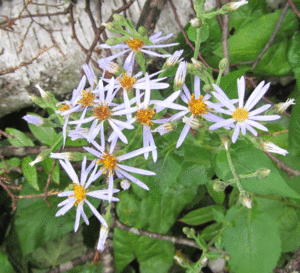Forked aster facts for kids
Quick facts for kids Forked aster |
|
|---|---|
 |
|
| Conservation status | |
| Scientific classification | |
| Synonyms | |
|
Aster furcatus E.S.Burgess |
The forked aster (scientific name: Eurybia furcata) is a type of plant that lives for many years. It is a perennial plant, meaning it grows back each spring from its roots. This plant belongs to the composite family, which includes other well-known flowers like sunflowers and daisies.
The forked aster is originally from the United States. It mainly grows in two areas: the Great Lakes region and the Ozark Mountains. This plant is not very common, and you can find it in states like Michigan, Wisconsin, Nebraska, Illinois, Iowa, Indiana, Missouri, and Arkansas.
Contents
What is the Forked Aster?
The forked aster is a beautiful wild flower. It is known for its unique appearance. The plant gets its common name, "forked aster," because its stems often branch out in a way that looks like a fork.
Appearance of the Plant
The forked aster has sturdy stems and green leaves. When it blooms, it produces lovely flowers. These flowers typically have white or pale purple petals. In the center of the flower, there is a yellow disc. The flowers usually appear in late summer and fall.
Where the Forked Aster Grows
This plant prefers specific places to grow. It does not like a lot of shade. You will often find it on rocky slopes that face north. These slopes are often made of limestone, dolomite, or sandstone.
It can also grow in other moist spots. These include places where water seeps out of the ground, like on bluffs. You might also see it in damp forests near streams. Sometimes, it can even pop up in areas that have been disturbed, like along roadsides.
Why is the Forked Aster Important?
The forked aster plays a role in its natural environment. Like many native plants, it provides food and habitat for insects and other small creatures. Its presence helps keep the ecosystem healthy.
Conservation Efforts
Because the forked aster is uncommon, it needs protection. It is part of a special collection called the National Collection of Endangered Plants. This collection is managed by the Center for Plant Conservation. Their goal is to protect rare plants in the United States. By including the forked aster, they help ensure its survival for future generations.


